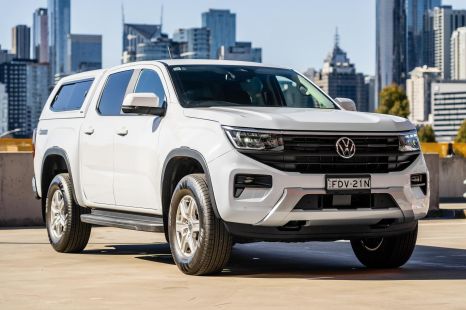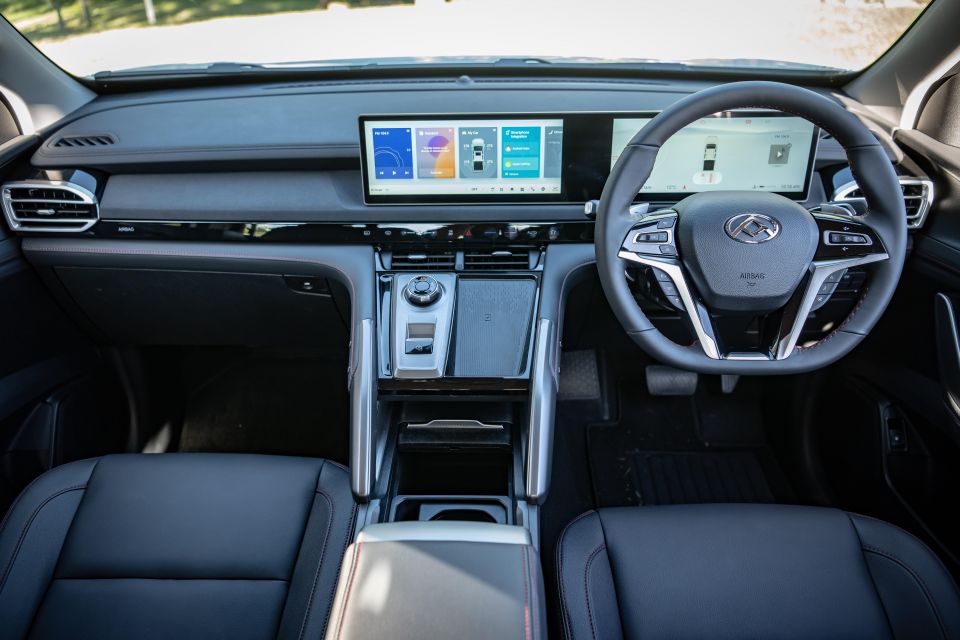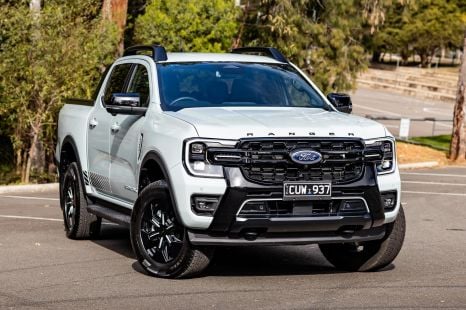

Max Davies
2025 Volkswagen Amarok Life TDI500 review
1 Month Ago
The new range-topper in LDV's cheap ute range isn’t all that cheap anymore, but it sees some significant and impressive improvements.



Quickly see how this car stacks up against its competition. Select any benchmark to see more details.
CarExpert helps new car buyers save thousands with expert reviews, honest advice, and transparent pricing – no dealer pressure and no sales games.
The LDV T60 Max Plus is here, and it looks almost like a new-generation take on this Chinese ute.

That’s because it has a different front end design that sets it apart from the other models in the range, and on the inside it is a vastly more impressive cabin with a pair of big screens, new controls and a heap more wow factor.
Speaking of wow, this ute has coil-spring rear suspension instead of the leaf-spring setup of the cheaper work-focused models below it, not to mention a revised engine and transmission tune for the carryover powertrain to make it more usable on the daily, according to LDV.
The existing versions of the LDV T60 Max remain, so it might be better to show you where the new Max Plus model sits in context of the existing line-up, and I’ve bolded them so you can see the price jump.

| Model Variant | Drive-Away Pricing – Private buyers |
|---|---|
| 2024 LDV T60 Max Pro manual | $39,042 |
| 2024 LDV T60 Max Pro auto | $41,148 |
| 2024 LDV T60 Max Luxe manual | $43,779 |
| 2024 LDV T60 Max Luxe auto | $45,884 |
| 2024 LDV T60 Max Mega Tub auto | $47,463 |
| 2024 LDV T60 Max Plus manual | $48,411 |
| 2024 LDV T60 Max Plus auto | $50,516 |
| 2024 LDV T60 Max Plus Mega Tub auto | $52,095 |
| Model Variant | Drive-Away Pricing – ABN holders |
|---|---|
| 2024 LDV T60 Max Pro manual | $36,990 |
| 2024 LDV T60 Max Pro auto | $38,990 |
| 2024 LDV T60 Max Luxe manual | $41,490 |
| 2024 LDV T60 Max Luxe auto | $43,490 |
| 2024 LDV T60 Max Mega Tub auto | $44,990 |
| 2024 LDV T60 Max Plus manual | $45,990 |
| 2024 LDV T60 Max Plus auto | $47,990 |
| 2024 LDV T60 Max Plus Mega Tub auto | $49,990 |
The vehicle tested here is the standard-length T60 Max Plus auto.
To see how the LDV T60 stacks up against the competition, check out our comparison tool.
Talk about a dramatic change.

Compared to the existing versions of the T60, the interior of the T60 Max Plus may well look like an all-new ute.
It isn’t. And there are still some ergonomic issues, like the lack of reach adjustment for the steering wheel and the slightly odd seat-base height, which feels like you’re sitting on stool.
But for those who want the view from up high, and can deal with some of the quirky design elements to this new design, it could be a nice spot.
For example, the auto models don’t have a traditional gear selector, anymore. Like the MIFA people-mover, the T60 Max Plus now has a column-shift selector similar to a Mercedes-Benz – trust me, it takes some getting used to.


It also has an ‘everything’ stalk on the left of the steering column, with high-beam light control, wipers, windscreen washer and blinkers all controlled through it.
If you’re wondering about the main lighting controls, like turning off the headlights or running a dipped-beam? That’s done through the media screen. For some buyers, particularly those in the country, that could be a deal-breaker.
Likewise, the haptic control panel bar below the screen with your fan and air-con (including demister front and rear) could be a turn-off, as tradies and farmers who wear gloves might struggle to get to terms with it.
At least the auto model gets a wireless phone charging pad, and wireless Apple CarPlay and Android Auto, while the manual versions (which don’t have a column shifter) make do with a wired connection and no wireless charger.


The driver cluster screen isn’t as feature rich as some others out there, but it does offer a crisp display for your digital speed readout.
The 12.3-inch touchscreen media unit is a big improvement over the existing display, but the menus take some learning. Like, you’d think there could be a button for seat heating? There’s not, it’s through the screen.
Thankfully there’s a home screen display that allows you to quickly turn on the driver’s seat heating on cold mornings. There’s also just a good old-fashioned button for the steering wheel heating.
The touchscreen has menus to toggle climate controls, and there are a few menus of configurable controls like safety settings and other vehicle adjustments. It’s not overwhelming, but it isn’t simple either. At least it’s really quick to respond to touch inputs, and it also reconnected flawlessly with my Apple iPhone every time I got back in.


Cabin storage is decent, with the shift to a column-shifter now allowing a heap more centre console space. There’s a lovely marble-like texture on the lid between the seats, and below it you’ll find a pair of cupholders which can be removed to give you a huge, deep hidey-hole – a nice spot to store some cash away from the apprentice perhaps.
There’s also a covered centre console bin with a couple of charging points, and the doors still feature decent bottle holders. But there are no pop-out cupholders anymore, despite the fact the dash has been reworked with much nicer textures and finishes.
Now, those seats? They’re electrically adjustable for both front-seat riders, heated too, and have a decent amount of comfort to them. It’s partly real leather apparently, and the red stitching? It’s an acquired taste.
There’s an impressive amount of cabin space though, with more knee room than many of the big name utes. At 182cm or 6’0” I managed to comfortably sit behind my own driving position with room to wiggle my legs and feet, and I had a couple of inches of clearance above my head.
There’s a small transmission tunnel intrusion between the back seats, but you can fit three adults across the back if you need to.




Plus, there are ISOFIX points in the window seats, and dedicated outboard top-tether points which is a big tick for parents out there who know what a struggle it is to get a top tether done up to a level that makes you feel confident. Many other utes just have a single attachment point behind the middle-seat headrest.
Rear riders get directional air-vents, a single USB-A charging point, map pockets in the seatbacks, a fold-down armrest with cupholders, and bottle holders in the doors. You can also fold up the base of the bench seat for extra dry storage if you aren’t using the spots for child seats, or you can fold down the seat backrest too.
Curious about length? The difference between the normal versions and the Mega Tub is sizeable. The Mega Tub is 5710mm long, some 315mm lengthier than the standard ute. It also has a sizeable 3490mm wheelbase, up from 3175mm in other versions.
As you’d expect, the tub length is considerably larger – 1800mm at the floor for the Mega Tub, compared with 1485mm for standard versions. Other tub measurements are unchanged: width – 1510mm; wheel arch gap – 1131mm; depth – 530mm.

| Dimensions | LDV T60 Max Plus |
|---|---|
| Length | 5395mm |
| Width | 1900mm |
| Height | 1819mm |
| Wheelbase | 3175mm |
| Tub width | 1510mm 1131mm (between arches) |
| Tub length | 1485mm |
| Tub height | 530mm |
To see how the LDV T60 stacks up against the competition, check out our comparison tool.
Powering the LDV T60 Max Plus is a 2.0-litre bi-turbo four-cylinder diesel engine producing 160kW of power (4000rpm) and 500Nm of torque (1500-2400rpm). Those are strong outputs – on par with a four-cylinder Volkswagen Amarok or Ford Ranger in fact.

But the Amarok and Ranger models that have those outputs don’t come with a manual option, whereas you can get one here – the choice is the cheaper six-speed manual, or an eight-speed automatic transmission from ZF.
Further, for the Max Plus, LDV says it has remapped the engine software “to ensure a more linear delivery of that power”.
Four-wheel drive is standard, with 2H high-range rear-wheel drive, 4H high-range, 4L low-range, and an Auto mode that uses “Intelligent Real-Time Torque on demand from BorgWarner” to apportion grunt where it’s needed most, and there’s an on-demand rear differential lock system.
The official combined cycle fuel consumption for the T60 Max Plus is 9.3 litres per 100km for the manual, and the auto is now rated at 8.9 litres per 100km (down from 9.3L in cheaper models).
My test drive included a run of highway, open road, urban and slow speed driving, and I threw 500kg of sandbags in the back to do a load test.
On the display I saw 10.3L/100km, which is a smidge lower than last time I drove a T60 (10.4L/100km, and I didn’t do a load test then…). The T60 has a 73-litre fuel tank.

| Model Variant | Payload |
|---|---|
| 2024 LDV T60 Max Plus manual | 840kg |
| 2024 LDV T60 Max Plus auto | 830kg |
| 2024 LDV T60 Max Plus Mega Tub auto | 800kg |
The payload for existing Luxe models ranges between 730kg and 750kg, depending on the spec, while the Pro variants range between 925kg and 935kg.
All LDV T60s have a 750kg unbraked towing capacity and 3000kg braked, which is lower than most utes in the class, but also arguably more realistic.
The gross vehicle mass (GVM) is 3050kg for the new Max Plus models, while the gross combination mass (GCM) is 6050kg.
There are a few significant differences between this model and others in the range, but don’t expect a quantum shift in the way this ute behaves itself on the road.

It’s not super soft now because it’s got coil spring rear suspension. In fact, it was surprising to me how firm it still felt without a load in the tub, but with that firmness comes a more predictable and likeable driving manner, because it’s not crashy or harsh.
In fact, it makes vehicles like the HiLux feel a bit rudimentary in terms of ride quality and comfort. In my extensive ute-testing experience, I’d say it’s on par with the Navaras and Tritons of the world.
Ride comfort is greatly improved with a load in, as I found when I put 500kg of sandbags in thanks to my mates at Lower Mountains Landscape Supplies.
It exhibited far less of the springy, multiple-rebound action that I felt in an existing T60 test, and indeed the settled nature of the suspension was a very surefooted and secure feeling. It took speed humps well, and the rear-end sagged only a smidge (about 5cm) with that amount of weight on board.

There’s more to the way the ute feels, too, with more predictable steering and dynamics thanks to the more sophisticated rear suspension. It’s not like an SUV to drive, but it certainly isn’t embarrassed in driving manners.
However, that’s despite the fact the brand has fitted Giti 4×4 HT152 tyres to this ute (265/60/R18) in place of the existing and excellent Continental tyres. These aren’t as good as the latter, but they do the job sufficiently enough.
The revision to the engine software clearly has had an influence on the drive, but perhaps not as big as it should have.
While the engine is decent and smooth enough under light and mid-throttle application at pace, and even reacts decently when you plant your foot to overtake on the freeway, it isn’t as good as it could be in stop-start driving.

CarExpert helps new car buyers save thousands with expert reviews, honest advice, and transparent pricing – no dealer pressure and no sales games.
When you’re on and off the throttle there is still some notable lag, and if you spend hours of your day driving in traffic you might get sick of it.
The eight-speed auto from ZF is also decently tuned, but it feels at odds with the engine at times, holding gears longer than you may expect in some situations. That was a character trait I criticised in the pre-updated model too.
And, it’s loud. LDV may claim to have fitted additional sound-deadening between the engine and the cabin, but bloody hell, they could have tripled the amount of noise foil.
It’s still really rattly and loud, particularly from a cold start and at low speeds. But thankfully, there’s little noise at highway pace and very little wind or road noise for a ute like this.

Moreover, the powertrain felt smoother and smarter with a load on board, with cleverer shifts and more linear feeling torque delivery over hilly roads up to 60km/h.
The four-wheel disc brakes felt better suited to non-loaded driving though, with a bit of a squelchy pedal feel with extra mass in the back.
While surround-view camera system seems like a massive win on paper, the quality is poor and the lens is badly affected by fog, dirt and direct sunlight. Such a shame because it could be great tech, but it just feels like a corner was cut to save cost.
On the whole, if you’re thinking the coil-sprung LDV isn’t going to be up to the task of hard work, I’d say you best think again – it was better than I expected.
The Max Plus models have some similar specs to the other models in the range, but make sure you check out the official specifications sheet to see the details.




LDV T60 Max Plus manual highlights:
T60 Max Plus auto adds:
T60 Max Plus Mega Tub auto adds:
The old LDV T60 managed a five-star ANCAP safety rating in 2017, with that rating valid until the end of 2024.

It received 14.46 out of 16 for the frontal offset test, 16.00 out of 16 for the side impact test, 2 out of 2 for the pole test, 3 out of 3 for seat belt reminders, good whiplash protection, acceptable pedestrian protection. The overall score was 35.46 out of 37.
Standard safety equipment includes:
T60 Max Luxe adds:
T60 Max Plus manual adds:
T60 Max Plus auto adds:
This ute comes with a seven-year/200,000km warranty, which is better than plenty of rivals with five years cover. There is also roadside assistance included for five years.

However, one thing that still hasn’t changed is LDV Australia’s approach to capped-price servicing.
There’s still no preset pricing for maintenance, which takes the guesswork out of operating costs for business and private buyers alike. It’s a shame as LDV is one of the few brands left in Australia that doesn’t have a capped-price servicing program.
But as I’ve found in the past, if you discuss the ongoing costs with your dealership, you should be able to get an idea of expected maintenance costs.
The new LDV T60 Max Plus is undoubtedly the best version of the Chinese ute so far.

It’s more comfortable in a mix of unladen driving, better with a load, more enticing inside, and has a meaner look to the exterior too.
There’s still room for improvement, but it comes across as a decent affordable option in the dual-cab ute space.
Click the images for the full gallery
MORE: Buy a LDV T60 MORE: Everything LDV T60
CarExpert helps new car buyers save thousands with expert reviews, honest advice, and transparent pricing – no dealer pressure and no sales games.
Matt has more than a decade of experience in automotive journalism, and loves exploring the pros and cons of new cars, delving into deep-dive industry stories, and going for a drive just for the fun of it.


Max Davies
1 Month Ago


Matt Campbell
17 Days Ago


Damion Smy
9 Days Ago


Josh Nevett
7 Days Ago


Damion Smy
7 Days Ago


William Stopford
7 Days Ago